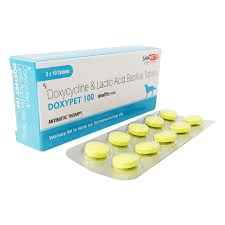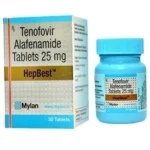Table of Contents
- Introduction to Doxypet 100
- What is Doxypet 100?
- How Does Doxypet 100 Work?
- Common Infections Treated by Doxypet 100
- Benefits of Using Doxypet 100
- Correct Dosage and Administration Guidelines
- Precautions to Follow While Using Doxypet 100
- Potential Side Effects of Doxypet 100
- Comparison: Doxypet 100 vs. Other Antibiotics
- Tips for Administering Doxypet 100 to Your Pet
- Frequently Asked Questions About Doxypet 100
- Conclusion
1. Introduction to Doxypet 100
Bacterial infections in pets can lead to severe health complications if left untreated. Conditions such as respiratory infections, skin infections, and tick-borne diseases can significantly impact your pet’s quality of life. Doxypet 100, a veterinary-grade antibiotic, has proven to be one of the most effective solutions to treat these infections. Its broad-spectrum action and targeted approach make it a preferred choice among veterinarians worldwide.
This article dives deep into what Doxypet 100 is, how it works, and its effectiveness in treating various bacterial infections. You’ll also learn about its proper usage, dosage guidelines, potential side effects, and tips to ensure your pet benefits from this powerful medication.
2. What is Doxypet 100?
Doxypet 100 is a veterinary antibiotic containing Doxycycline Hyclate, a member of the tetracycline family. It is specially formulated for animals and is widely used to treat bacterial infections in pets like dogs and cats. This medication works effectively against a broad spectrum of bacteria, including both gram-positive and gram-negative strains.
Its primary use includes treating respiratory tract infections, urinary tract infections (UTIs), skin infections, and diseases caused by tick bites, such as Lyme disease and Ehrlichiosis. Due to its ability to combat a variety of bacterial infections, Doxypet 100 is often prescribed as a first-line treatment in veterinary care.
3. How Does Doxypet 100 Work?
The active ingredient in Doxypet 100, doxycycline, works by inhibiting bacterial protein synthesis. When bacteria enter your pet’s body, they require proteins to grow and multiply. Doxycycline binds to the 30S ribosomal subunit of bacterial cells, effectively blocking the production of these essential proteins.
This mechanism halts bacterial replication, allowing your pet’s immune system to eliminate the remaining bacteria. Unlike bactericidal antibiotics that kill bacteria outright, Doxypet 100 is bacteriostatic—it prevents the bacteria from multiplying, giving the body’s natural defenses time to recover and combat the infection.
Additionally, Doxypet 100 has high bioavailability, meaning it is absorbed quickly and begins to work within hours of administration. This makes it particularly effective in treating acute and severe infections.
4. Common Infections Treated by Doxypet 100
Doxypet 100 is a versatile antibiotic that addresses a wide range of bacterial infections in pets. Some of the most common conditions it treats include:
- Respiratory Infections: Pneumonia, bronchitis, and kennel cough are common in pets, especially dogs, and can cause difficulty breathing if untreated.
- Skin and Soft Tissue Infections: Bacterial skin infections, wounds, and abscesses can lead to complications if not addressed promptly.
- Urinary Tract Infections (UTIs): UTIs are common in both dogs and cats and can cause discomfort, frequent urination, and blood in the urine.
- Tick-Borne Diseases: Lyme disease, Ehrlichiosis, and Rocky Mountain spotted fever are all caused by bacteria transmitted through tick bites.
- Leptospirosis: A severe bacterial infection that can affect the kidneys and liver, leptospirosis can be life-threatening without treatment.
- Mycoplasma Infections: These infections, often affecting the respiratory system, are effectively treated with Doxypet 100.
This broad-spectrum antibiotic ensures that your pet receives comprehensive care for various bacterial infections.
5. Benefits of Using Doxypet 100
Doxypet 100 offers several significant benefits, making it one of the top choices in veterinary medicine:
- Broad-Spectrum Efficacy: Its ability to combat a wide range of bacteria ensures it is effective for multiple types of infections.
- Targeted Action: Doxycycline penetrates tissues and cells, making it effective against intracellular bacteria like those responsible for tick-borne diseases.
- Ease of Administration: Doxypet 100 tablets are easy to administer and can be given with or without food.
- Minimal Side Effects: Compared to older antibiotics, Doxypet 100 has fewer gastrointestinal side effects.
- Fast-Acting Results: Pets often show significant improvement within a few days of starting treatment.
- Safe for Long-Term Use: In chronic conditions, Doxypet 100 can be used for extended periods under veterinary supervision.
6. Correct Dosage and Administration Guidelines
The proper dosage of Doxypet 100 varies based on the pet’s weight, age, and the severity of the infection. The general recommendation is 5-10 mg per kilogram of body weight once or twice daily.
- Duration: Treatment typically lasts for 7-14 days, but severe infections may require longer courses.
- Administration:
- Administer the tablet orally.
- It is often recommended to give the medication with food or water to minimize the risk of stomach upset.
Skipping doses or stopping treatment early can result in antibiotic resistance, so it’s crucial to complete the full course prescribed by your veterinarian.
7. Precautions to Follow While Using Doxypet 100
While Doxypet 100 is generally safe, there are some precautions to ensure its effectiveness and safety:
- Avoid Dairy Products: Calcium can interfere with the absorption of doxycycline, reducing its efficacy.
- Monitor for Allergic Reactions: Although rare, allergic reactions such as swelling, rash, or difficulty breathing require immediate veterinary attention.
- Keep Hydrated: Ensure your pet drinks plenty of water to prevent esophageal irritation.
- Pregnant and Nursing Pets: The safety of Doxypet 100 in pregnant or lactating animals has not been fully established. Consult your veterinarian before use.
- Concurrent Medications: Inform your vet about any other medications your pet is taking to avoid interactions.
8. Potential Side Effects of Doxypet 100
Doxypet 100 is well-tolerated in most cases, but some pets may experience side effects, including:
- Mild Side Effects:
- Vomiting
- Diarrhea
- Reduced appetite
- Severe Side Effects:
- Esophageal irritation or ulcers (if not administered with water or food)
- Allergic reactions such as swelling or difficulty breathing
- Liver or kidney complications in rare cases
If side effects persist or worsen, discontinue use and consult your veterinarian immediately.
9. Comparison: Doxypet 100 vs. Other Antibiotics
Doxypet 100 stands out compared to other antibiotics like amoxicillin or cephalexin due to its broad-spectrum efficacy and ability to treat intracellular bacteria. Unlike bactericidal antibiotics that kill bacteria directly, Doxypet 100’s bacteriostatic action is more suitable for long-term management of chronic conditions. Its safety profile and reduced side effects make it a preferred option for sensitive pets.
10. Tips for Administering Doxypet 100 to Your Pet
Administering medication to pets can be challenging. Here are some tips to make the process easier:
- Use Pill Pockets: Specially designed treats with a pocket for pills can mask the taste and make administration easier.
- Crush and Mix: Crush the tablet and mix it with your pet’s favorite wet food to disguise the taste.
- Direct Method: Place the tablet at the back of your pet’s mouth and encourage swallowing by gently stroking their throat.
- Positive Reinforcement: Reward your pet with praise or a small treat after they take their medication.
11. Frequently Asked Questions About Doxypet 100
Q1: Can Doxypet 100 be used for cats?
Yes, Doxypet 100 is safe for cats when prescribed by a veterinarian.
Q2: Can I stop treatment if my pet seems better?
No, always complete the full course to prevent antibiotic resistance and recurrence of the infection.
Q3: What should I do if I miss a dose?
Administer the missed dose as soon as possible, but skip it if it’s close to the next dose. Never double up on doses.
12. Conclusion
Doxypet 100 is a highly effective antibiotic that addresses a wide variety of bacterial infections in pets. Its broad-spectrum action, ease of administration, and minimal side effects make it a go-to choice for veterinarians. By following proper dosage and administration guidelines, as well as taking necessary precautions, you can ensure your pet recovers quickly and stays healthy.
Always consult your veterinarian before starting any new medication to ensure it’s the best choice for your pet’s specific needs. With proper care and attention, Doxypet 100 can help your furry friend lead a healthier, happier life.



